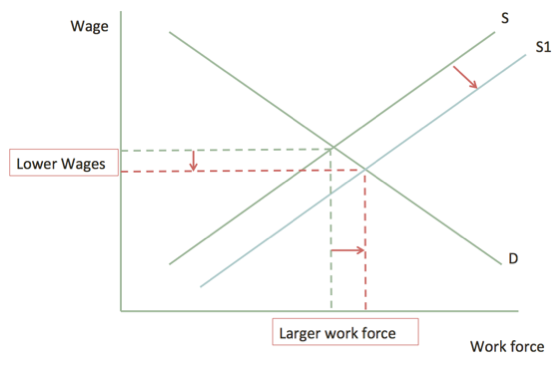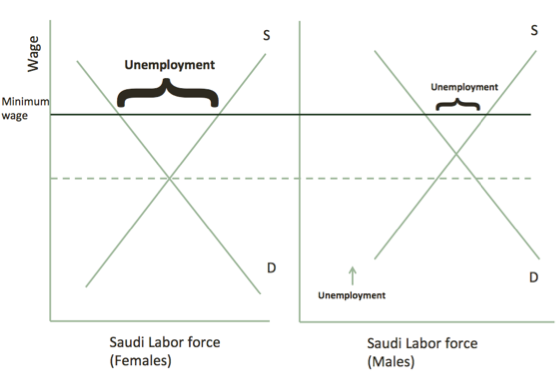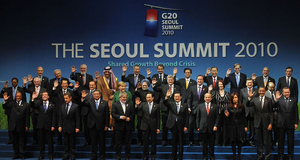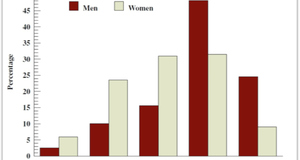The Labor Market in Saudi Arabia: Foreign Workers, Unemployment, and Minimum Wage
By
2014, Vol. 6 No. 06 | pg. 1/2 | »
IN THIS ARTICLE
KEYWORDS
The issue of foreign labor in Saudi Arabia is now one that touches all corners of the globe. Since 30% of Saudi Arabia's population of 27.3 million are immigrants from other countries, changes in Saudi labor laws affect not only the workers but their families around the world. According to an IMF study (International Monetary Fund), remittances from foreign labor in Saudi Arabia account for 6.2% of Saudi Arabia's gross domestic product (GDP) of $927.8 billion and are an important source of income for many countries (International Monetary Fund, 2012; The World Factbook, 2013). On the other hand, Saudi nationals have witnessed high levels of unemployment for the past decade. Unemployment peaked in 2011 at 12.4% (Saudi Ministry of Labor, 2012); this was due mainly to structural problems such as competition from lower paid foreign workers. In addition to the problem of the many unskilled Saudi workers who need training in order to be integrated into the labor market, there is a demographic issue: the largest age group is the youth between 20 and 34. The labor market needs to accommodate this large number of workers every year, estimated to be around 300,000 (Fakieh, 2013), making up almost half the unemployed population of 622,533 (Central Department of Statistics, 2013). Therefore, the Saudi government, with its new labor minister, Adel Fakieh, who was appointed in late 2010, started drastic measures to lower the unemployment rate by introducing innovative programs that affected the supply and demand of labor in the Saudi labor market. In this report we study the effects of these interventions on the wage rate. We use the international labor mobility theory as a framework for our analysis, in addition to the general labor supply and demand theory.International Labor Mobility in TheoryThe theory of international labor mobility suggests that workers will move from their home countries to foreign countries searching for higher wages (immigration). This in turn will cause a rise in wages in the home countries due to a smaller supply of workers, and a decrease in wages in the foreign countries due to increases in the supply of workers. This is especially true for low-skilled workers because there are more unskilled people migrating at any point in time, due to the scarcity of skilled labor. Below is a graphical interpretation of the theory(Krugman, Obstfeld, & Melitz, 2012).
From the graph we can see that as the supply of labor increases with the flow of immigrants the new equilibrium point is at a lower wage rate. This has been empirically tested in many studies. For example, Dr. George J. Borjas, Professor of Economics and Social Policy at the Kennedy School of Government, Harvard University, in his paper for the Center for Immigration Studies in the United States, stated that a 10% increase in the size of the immigrant labor force in a particular skill group will cause annual earnings to drop by 7.1% for salaried workers. Overall, immigration has an unfavorable effect on wages and employment of competing natives (Borjas, 2004). Whether or not this is good for the economy is an issue widely debated in the United States. People advocating easier immigration policies argue that allowing more immigrants to enter the market enables corporations to be more competitive in the global market and therefore help the economy grow as a whole: companies will grow and therefore employ more workers, which will increase income that will therefore increase consumption. On the other hand, people who oppose easier immigration policies argue that immigrants are more desperate to work and will work for much less than natives, making it impossible for natives to compete with them; these policies would cause many natives to lose their jobs or to work for so much less money that they would end up requiring social welfare aid. So it would be safe to say that while companies may definitely benefit more from immigration than by retaining native workers, from a macro viewpoint both sides have reasonable arguments. The Saudi Labor MarketThe Saudi labor market can be described as highly dependent on foreign labor, especially in the private sector; for example, in 2010 Saudis accounted for only 7% of the labor in the private sector and 47.1% of the overall labor force(Fakieh, 2013). There are many reasons for this, one being the large demand for workers in the oil industry, which is the biggest contributor to the economy; another is that Saudi Arabia is a large country and has mega-infrastructure projects that require temporary labor only for the duration of the projects and therefore do not provide secure jobs for natives. Other reasons are cultural; for instance, people find it shameful to work as janitors, binmen (garbage collectors), or cleaning in general, or in jobs like plumbing, construction, and gardening. Having all of these foreign workers means that Saudi Arabia has two distinct labor markets: one for Saudis and one for foreigners. They are distinct because they have very different characteristics. For example, the average monthly wage for Saudis is $1,280, whereas the average monthly wage for non-Saudis is $250(Saudi Ministry of Labor, 2012). Also, there is no unemployment in the foreign labor force, because all expatriates must have a job contract at every point of time they are in the country. This gives them much less mobility than Saudis, who can easily change jobs. From this we can see that part of the unemployment problem in Saudi Arabia is due to the large number of foreign workers who receive substantially lower wages and are constrained to work with their sponsors, making them much more attractive than Saudis to the private sector. Unemployment in Saudi ArabiaWhen looking more closely at the 2011 unemployment figure of 12.4%, we find that one factor making it so high is the female sector of the Saudi labor force. Females have an unemployment rate of about 35%, as opposed to 7.4% for males. So the question is why the female unemployment rate is so high. When looking at the historical data, we find that the female unemployment rate was 15.8% in 1999, 26.3% in 2006, and 35.8% in 2012. The rate of male unemployment has been much more steady, and there could be numerous reasons for this(Saudi Ministry of Labor, 2012). First, culture and religion make it harder for women to find suitable jobs, and so they have fewer employment opportunities. Second, Saudi culture is changing, with more women wanting to enter the labor force rather than staying home to raise children (similar to the changes that occurred in the US labor force beginning in the 1960s). Third, some factor may be exaggerating the number, so that the actual unemployment rate is much lower. This could be explained by the fact that with the introduction of a social welfare program (Hafiz) by which a person without a job could apply for a monthly allowance of about $500, 80% of the people who applied were females. It could be argued that applying for an effortless $500 monthly allowance is different from actively looking for a job(Fakieh, 2013). Finally, when the minimum wage was introduced, unemployment increased for females because they had a lower wage rate than men, and so the gap widened between those who wanted to work and those who actually found a job. This can be graphically interpreted as follows:
Saudi Government InterventionTo address the issue of unemployment, the government needed to deploy strategies that would solve the structural problems built into the labor market; fiscal and monetary policies would not do the job, because the economy was growing and didn't need any stimulus. The idea was to let the private sector take on the challenge of employing more Saudis (Saudization) by enforcing a minimum Saudization rate in all private companies (Nitaqat). They also initiated labor laws that caused the deportation of about 20% of the foreign labor; this made competition less severe between natives and expatriates. Finally, they addressed the issue of reluctance to work because of low wages by introducing a minimum wage for Saudis. This, in theory, would increase unemployment, because the number of people who would like to work under the minimum wage rate would exceed the demand for workers by companies; but in the Saudi case, because of the demand created by the other programs, jobs were available. We will now go into slight detail about each of the three initiatives and their effect on the wage rate.Continued on Next Page » Suggested Reading from Inquiries Journal
Inquiries Journal provides undergraduate and graduate students around the world a platform for the wide dissemination of academic work over a range of core disciplines. Representing the work of students from hundreds of institutions around the globe, Inquiries Journal's large database of academic articles is completely free. Learn more | Blog | Submit Latest in Economics |


















